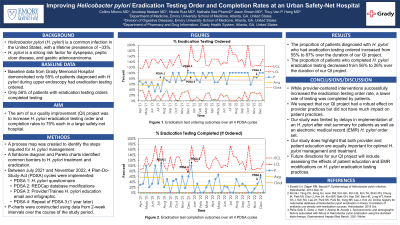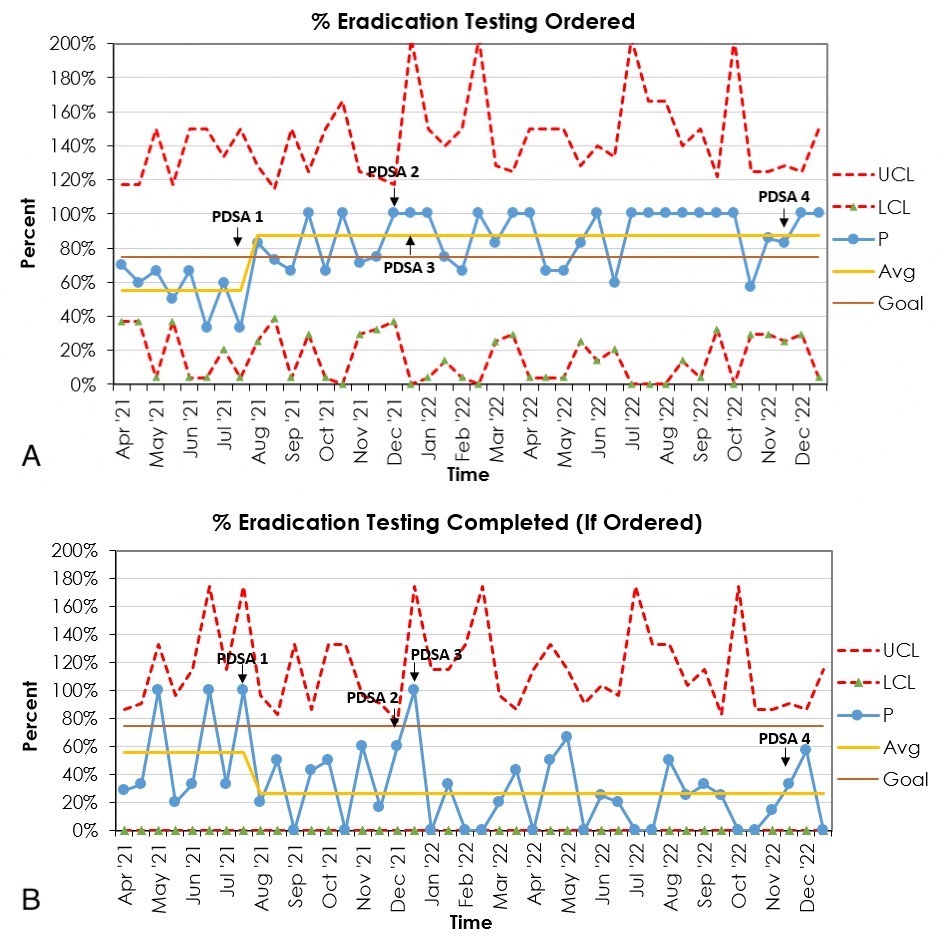Tuesday Poster Session
Category: Stomach
P4185 - Improving Helicobacter pylori Eradication Testing Order and Completion Rates at an Urban Safety-Net Hospital
Tuesday, October 24, 2023
10:30 AM - 4:00 PM PT
Location: Exhibit Hall

Has Audio

Collins Mbonu, MD
Emory University
Atlanta, Georgia
Presenting Author(s)
Collins Mbonu, MD1, Anudeep Neelam, MD2, Nicole Ruiz, MD1, Nathalie See, PharmD3, Jason Brown, MD1, Thuy-Van Hang, MD4
1Emory University, Atlanta, GA; 2Mount Sinai Morningside West, New York, NY; 3Grady Health System, Atlanta, GA; 4Atlanta VA Medical Center, Emory University School of Medicine, Atlanta, GA
Introduction: Helicobacter pylori (H. pylori) is a common infection in the United States, with a lifetime prevalence of approximately 33%. It is a strong risk factor for dyspepsia, peptic ulcer disease, and gastric adenocarcinoma; ensuring eradication of this infection is thus imperative. Baseline data from our hospital demonstrated only 55% of patients diagnosed with H. pylori during upper endoscopy had eradication testing ordered. Of these patients, just 56% completed testing. This quality improvement project aimed to increase eradication testing order and completion rates to 75% each.
Methods: A process map was created to identify the steps required for H. pylori management after upper endoscopy. A fishbone diagram and Pareto charts identified common barriers to H. pylori treatment and eradication. Between July 2021 and November 2022, 4 Plan-Do-Study-Act (PDSA) cycles were implemented and P charts with data from every 2 weeks were created.
Results: PDSA 1 focused on surveying providers on treatment practices for H. pylori via a questionnaire disseminated among gastrointestinal (GI), family medicine, and internal medicine faculty and trainees. PDSA 2 involved making modifications to the pathology database used by the GI team (REDCap) to include eradication test ordering information. For PDSA 3, a provider education email was sent reviewing H. pylori treatment and eradication testing guidelines. The final PDSA was a repeat provider education email sent approximately 1 year after PDSA 3. The average proportion of patients diagnosed with H. pylori who had eradication testing ordered increased from 55% to 87% with these interventions. However, mean eradication testing completion decreased from 56% to 26%.
Discussion: While provider-centered interventions successfully increased the eradication testing order rate, less testing was completed by patients. An after visit summary template and electronic medical record (EMR) order set for H. pylori treatment and eradication were drafted between PDSA 1 & 2 but have yet to be approved by administration. Study limitations included the lack of H. pylori urea breath testing and aforementioned system delays in the implementation of patient education materials and a H. pylori order set. Our study demonstrates the importance of both provider and patient education on improving H. pylori management. Future directions for our study will include assessing the effects of patient education and EMR modifications on H. pylori eradication testing practices.

Disclosures:
Collins Mbonu, MD1, Anudeep Neelam, MD2, Nicole Ruiz, MD1, Nathalie See, PharmD3, Jason Brown, MD1, Thuy-Van Hang, MD4. P4185 - Improving Helicobacter pylori Eradication Testing Order and Completion Rates at an Urban Safety-Net Hospital, ACG 2023 Annual Scientific Meeting Abstracts. Vancouver, BC, Canada: American College of Gastroenterology.
1Emory University, Atlanta, GA; 2Mount Sinai Morningside West, New York, NY; 3Grady Health System, Atlanta, GA; 4Atlanta VA Medical Center, Emory University School of Medicine, Atlanta, GA
Introduction: Helicobacter pylori (H. pylori) is a common infection in the United States, with a lifetime prevalence of approximately 33%. It is a strong risk factor for dyspepsia, peptic ulcer disease, and gastric adenocarcinoma; ensuring eradication of this infection is thus imperative. Baseline data from our hospital demonstrated only 55% of patients diagnosed with H. pylori during upper endoscopy had eradication testing ordered. Of these patients, just 56% completed testing. This quality improvement project aimed to increase eradication testing order and completion rates to 75% each.
Methods: A process map was created to identify the steps required for H. pylori management after upper endoscopy. A fishbone diagram and Pareto charts identified common barriers to H. pylori treatment and eradication. Between July 2021 and November 2022, 4 Plan-Do-Study-Act (PDSA) cycles were implemented and P charts with data from every 2 weeks were created.
Results: PDSA 1 focused on surveying providers on treatment practices for H. pylori via a questionnaire disseminated among gastrointestinal (GI), family medicine, and internal medicine faculty and trainees. PDSA 2 involved making modifications to the pathology database used by the GI team (REDCap) to include eradication test ordering information. For PDSA 3, a provider education email was sent reviewing H. pylori treatment and eradication testing guidelines. The final PDSA was a repeat provider education email sent approximately 1 year after PDSA 3. The average proportion of patients diagnosed with H. pylori who had eradication testing ordered increased from 55% to 87% with these interventions. However, mean eradication testing completion decreased from 56% to 26%.
Discussion: While provider-centered interventions successfully increased the eradication testing order rate, less testing was completed by patients. An after visit summary template and electronic medical record (EMR) order set for H. pylori treatment and eradication were drafted between PDSA 1 & 2 but have yet to be approved by administration. Study limitations included the lack of H. pylori urea breath testing and aforementioned system delays in the implementation of patient education materials and a H. pylori order set. Our study demonstrates the importance of both provider and patient education on improving H. pylori management. Future directions for our study will include assessing the effects of patient education and EMR modifications on H. pylori eradication testing practices.

Figure: P charts illustrating A) provider eradication testing order rates and B) patient eradication testing completion rates over the course of the intervention period in 2-week intervals. Abbreviations: UCL, upper control limit; LCL, lower control limit; P, proportion; Avg, average.
Disclosures:
Collins Mbonu indicated no relevant financial relationships.
Anudeep Neelam indicated no relevant financial relationships.
Nicole Ruiz indicated no relevant financial relationships.
Nathalie See indicated no relevant financial relationships.
Jason Brown indicated no relevant financial relationships.
Thuy-Van Hang indicated no relevant financial relationships.
Collins Mbonu, MD1, Anudeep Neelam, MD2, Nicole Ruiz, MD1, Nathalie See, PharmD3, Jason Brown, MD1, Thuy-Van Hang, MD4. P4185 - Improving Helicobacter pylori Eradication Testing Order and Completion Rates at an Urban Safety-Net Hospital, ACG 2023 Annual Scientific Meeting Abstracts. Vancouver, BC, Canada: American College of Gastroenterology.

